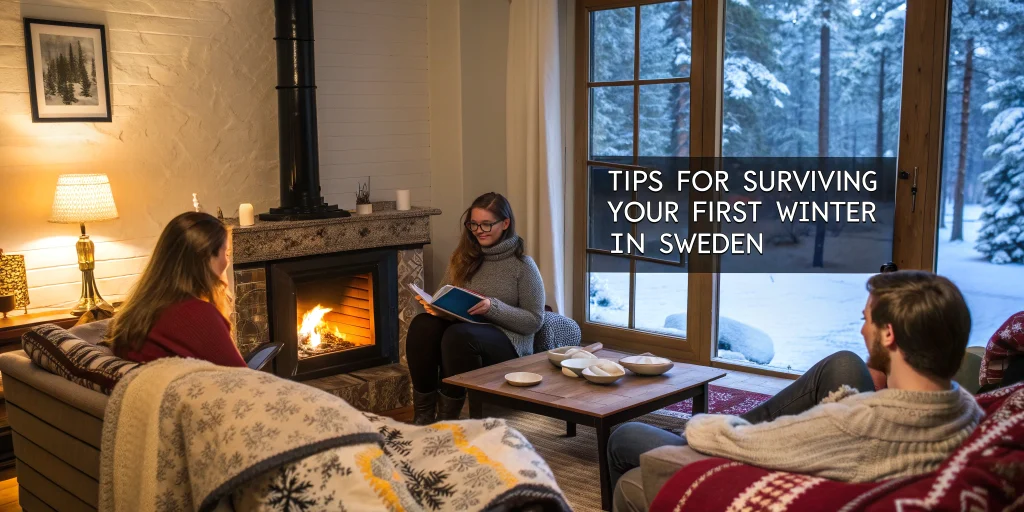Tips for Surviving Your First Winter in Sweden: A Guide for International Students
Quick Navigation
- Understanding Swedish Winter
- Dress Appropriately for the Swedish Winter
- Create a Cozy and Inviting Home Environment
- Prioritize Outdoor Time to Enhance Wellbeing
- Take Care of Your Mental Health During Darker Months
- How Study in Sweden Supports You Through the Winter
- Final Thoughts
- Take the Next Step with Study in Sweden
Understanding Swedish Winter: More Than Just Cold Weather
Sweden’s winters can last from November through March, with temperatures often dropping below freezing, accompanied by snow and icy conditions. In northern parts, daylight hours can be as short as a few hours a day, impacting mood and routine. Preparing for this seasonal shift goes beyond packing warm clothes; it involves embracing lifestyle changes that promote wellbeing and engagement with Swedish culture.
Dress Appropriately for the Swedish Winter
One of the most essential strategies for coping with winter is to dress in layers according to the Swedish philosophy: “There is no such thing as bad weather, only bad clothing.” Adopting this mindset ensures you stay warm, dry, and comfortable.
Layering Is Key
Wearing multiple layers traps heat and allows flexibility as you move between cold outdoor environments and heated indoor spaces. Consider the following:
- Base Layer: Opt for thermal underwear or woolen undergarments that wick moisture away and retain heat.
- Middle Layer: Fleece or wool sweaters provide insulation.
- Outer Layer: A waterproof and wind-resistant coat protects against snow and chilly winds.
Essential Winter Gear
Investing in quality winter accessories is crucial:
- Warm Winter Coat: Preferably one that covers your hips and has good insulation.
- Gloves: Insulated and waterproof gloves to keep your hands warm.
- Scarf and Hat: Vital for protecting your neck and head, where significant heat loss occurs.
- Winter Boots: Choose boots with thick soles, good traction to prevent slipping on ice, and waterproof materials.
Skincare During Winter
Cold air and indoor heating can dry out your skin. Apply protective lip balm and moisturisers designed for winter conditions to prevent chapping and irritation.
For a detailed guide on dressing the Swedish way for winter, explore our 5 Tips to Survive the Winter the Swedish Way.
Create a Cozy and Inviting Home Environment
With limited daylight and more time spent indoors, cultivating a warm and comfortable living space is vital for your mental health and overall wellbeing.
Embrace “Mysigt” – The Swedish Coziness
“Mysigt” is a Swedish concept focusing on coziness, comfort, and warmth—especially important during the long winter months. Here are some ways to create a mysigt environment:
- Use warm lighting, such as candles or soft lamps, to combat the gloom.
- Decorate with soft textiles like blankets, cushions, and rugs.
- Maintain a clean and organized space to promote relaxation.
Warm Beverages to the Rescue
Keeping a supply of hot drinks like tea, coffee, or hot chocolate can significantly boost comfort and provide a moment of relaxation amidst a busy schedule.
Building these comforting habits can transform your living space into a sanctuary from the cold outside.
Prioritize Outdoor Time to Enhance Wellbeing
While retreating indoors might seem intuitive during winter, spending time outside is essential for physical and mental health.
Maximise Daylight Exposure
Limited daylight can lead to seasonal affective disorder (SAD). To counter this:
- Spend time outdoors during daylight hours, even if it’s cold.
- Consider walking or cycling to your university to combine outdoor exposure with daily routines.
Dress Smart and Enjoy Winter Activities
Proper clothing extends your comfort zone outdoors, enabling you to partake in quintessentially Swedish winter activities such as skiing, ice skating, or taking serene snow walks. Engaging in these activities shifts your perception of winter from a challenge to an opportunity.
Students often report feeling a heightened sense of community and wellbeing through participation in winter sports and events.
Take Care of Your Mental Health During Darker Months
The Swedish winter’s reduced sunlight, combined with colder temperatures, can affect mood and mental wellness. Being proactive about your mental health is critical.
Avoid Prolonged Isolation
Though your warm apartment may be tempting to remain in, extended indoor isolation can lead to feelings of loneliness and depression. Regular social interactions and outdoor activities help maintain mental balance.
Explore Beyond Your Immediate Area
Weekend excursions to nearby nature spots, such as cabins near Stockholm or forest retreats, offer refreshing breaks from city life. Exposure to nature and varied environments supports mental restoration and stress relief.
If you feel symptoms of depression or anxiety, don’t hesitate to reach out to your university’s student health services or community support groups.
How Study in Sweden Supports You Through the Winter
At Study in Sweden, we are dedicated to supporting international students during all aspects of their journey, including adjusting to the Swedish climate. Our platform offers:
- Practical guidance on cultural adaptation and wellbeing.
- Resources for student health and safety during winter.
- Connections to university admissions teams and recruitment partners who prioritise student support services.
Explore our University Admissions and International Recruitment sections to learn how we help institutions create welcoming environments for international students.
Final Thoughts: Embrace Winter as Part of Your Swedish Experience
Surviving your first winter in Sweden involves thoughtful preparation and a positive mindset. By dressing appropriately, creating a cozy home, spending time outdoors, and caring for your mental health, you will not only endure Swedish winter but come to appreciate its unique beauty and traditions.
Swedish winter also presents a unique cultural experience—embracing it fully can enrich your time as an international student and enhance your personal growth.
Take the Next Step with Study in Sweden
Are you ready to make the most of your experience as an international student in Sweden? Explore the available resources and connect with a supportive community.

